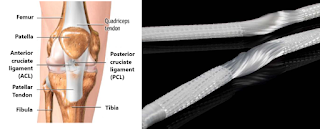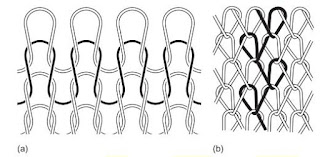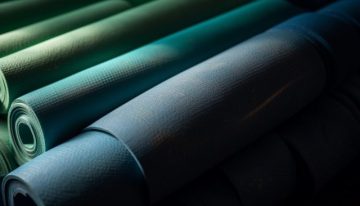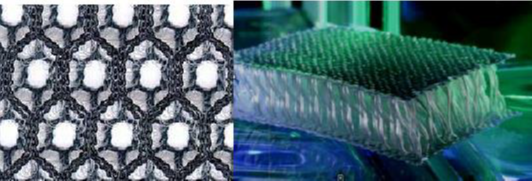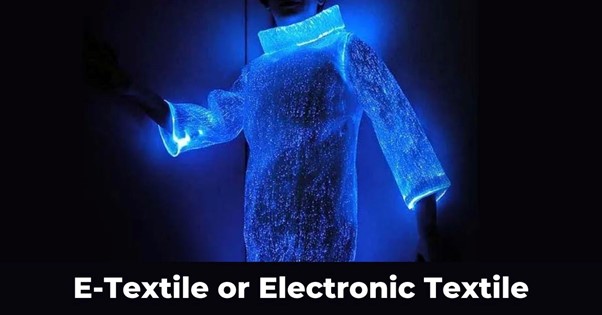Md. Emdad Sarker
Assistant Professor
Department of Fabric Engineering, BUTEX
Technical knitting is an advanced capability which allows textile components to be used in the technical field rather than traditional textiles. Technical knitting is an exciting capability, making it possible to create ground-breaking textile structures, constructions and textures as fully fashioned textile components which just can’t be achieved in flat-weaving [1]. In this article, some technical knitted fabrics along with their applications have been described.
Applications of Technical Knitted Fabrics
Assistant Professor
Department of Fabric Engineering, BUTEX
Technical knitting is an advanced capability which allows textile components to be used in the technical field rather than traditional textiles. Technical knitting is an exciting capability, making it possible to create ground-breaking textile structures, constructions and textures as fully fashioned textile components which just can’t be achieved in flat-weaving [1]. In this article, some technical knitted fabrics along with their applications have been described.
Applications of Technical Knitted Fabrics
1. Bandages
Bandages are designed to perform a whole variety of specific functions depending upon the final medical requirement. The most common application for bandages is to hold dressings in place over wounds. Such bandages include lightweight knitted or simple open weave fabrics made from cotton or viscose that are cut into strips then scoured, bleached, and sterilised. Elasticated yarns are incorporated into the fabric structure to impart support and conforming characteristics. Knitted bandages can be produced in tubular form in varying diameters on either warp or weft knitting machines. Compression bandages are used for the treatment and prevention of deep vein thrombosis (DVT), leg ulceration, and varicose veins and are designed to exert a required amount of compression on the leg when applied at a constant tension [2].
 |
| Figure-1 Tubular bandage |
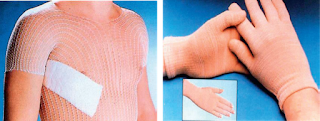 |
| Figure-2 Tubular elasticated net garment and pressure gloves |
 |
| Figure-3 Lumber or abdominal support |
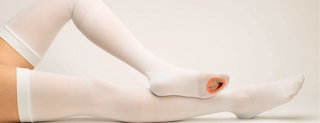 |
| Figure-4 Anti-embolism stockings |
Cardiovascular implants
Straight or branched grafts are possible by using either weft or warp knitting technology. Polyester vascular grafts can be heat set into a crimped configuration that improves the handling characteristics. During implantation, the surgeon can bend and adjust the length of the graft, which, owing to the crimp or corrugation, allows the graft to retain its circular cross-section [3],[4]. Knitted vascular grafts have a porous structure which allows the graft to become encapsulated with new tissue, but the porosity can be disadvantageous since blood leakage (haemorrhage) can occur through the interstices directly after implantation.
Knitted prostheses are either single jersey or warp-knitted velour structures. In knitted structures, the strength and porosity of the graft are influenced by loop configuration. Knitted grafts generally have high porosity (2000 ml/min/cm2) and low strength as compared to the woven ones. Knitted prostheses require precoating to prevent excessive blood loss during implantation.
Nowadays, Vascular prosthesis is being manufactured to allow deep penetration of collagen bovine in polyester filament by both sides. This allows an excellent demonstration of seal that it is indicated by the maximum permeability of 0.1 ml/cm2/min. The Albo Graft point of mesh and textile enables the easy passage of the suture through the wall, even in the most difficult anatomic situations.
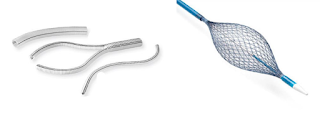 |
| Figure-5 Vascular Prosthesis [5] and non-occlusive catheter [6] |
The unballoon non-occlusive modelling catheter is being manufactured by LeMaitre Vascular, Inc., U.S.A. It allows the modelling of aortic stent grafts without occluding blood flow. The nitinol (an alloy of nickel and titanium) mesh expands, allowing modelling of the stent-graft (blood vessel to aid healing or relieve an obstruction) snugly to the vessel wall.
Artificial ligament
Proflex ligament is made of polyethene terephthalate polyester (PET) and consists of multiple braided tubes. Gore-Tex® is a knitted cable with eyelets on each end. Polyurethane urea elastomeric fibres for ACL reconstruction have been produced by wet spinning. These fibres possess high strength, high abrasion, and tissue compatibility. The degradation rates and biocompatibility of ACL made from polyurethane urea fibres were successfully tested. The morphological behaviour and bone anchoring property of ACL made of polyethene fibres have been reported elsewhere.
The requirements of an artificial ligament are extensive and it must have at least three important properties, such as high tensile strength, high elongation, and right stiffness, to match the compliance of a normal ACL [2].
The style of the filter will also determine the complexity of the sleeve design. Apart from knitted fabrics, which for this purpose are produced in tubular form, the chosen filter media will first have to be slit to an appropriate width and then formed into a tube as shown in Figure-7.
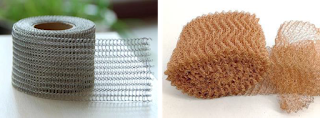 |
| Figure-7 Knitted wire mesh [8] [9] |
The developments in surgical drapes have led to the use of loop-raised, warp-knitted polyester fabrics that are laminated back to back and contain microporous PTFE films in the middle for permeability, comfort, and resistance to microbiological contaminants as shown in Figure-8(a).
A number of weft- and warp-knitted pile or fleece fabrics made of polyester are also used as part of a composite material which includes foam as well as PVC sheets for use as incontinence mats as shown in Figure-8(b).
Surgical hosiery with graduated compression characteristics is used for a number of purposes, ranging from light support for the limb to the treatment of venous disorders. Knee and elbow caps, which are normally shaped during knitting on circular machines and may also contain elastomeric threads, are worn for support and compression during physically active sports or for protection.
Industrial Felt
Industrial felt is manufactured by blending, pressing, fulling and drying, to produce a non-woven homogenous mat of fibre, which can exhibit a wide variety of properties depending on the final hardness, thickness and blend of wool used in its make-up.
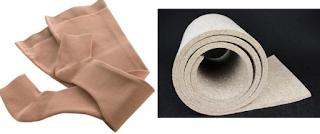 |
| Figure-9 Surgical hosiery [12] and Industrial Felt [13] |
References:
- https://www.camirafabrics.com/technical-knitting
- A. R.
Horrocks and S. C. Anand, Handbook of Technical Textiles Volume-2. 2000. - Thomas GB.
Textiles 1975;4:7–12. - Dias, T.,
Fernando, A., Choy, P.K., Xie, P., Knitting Seamless Three-Dimensional Shell
Structures on Modern Electronic Flat Bed Knitting Machines, Bolton College,
1999, pp. 36-43 - https://www.interempresas.net/Medical-hospital-equipment/Companies-Products/Product-Polyester-vascular-prosthesis-LeMaitre-AlboGraft-102916.html
- http://www.somnotec.net/portfolio-items/unballoon-non-occlusive-modeling-catheter/
- https://www.coringroup.com/au/solutions/lars/#Info
- https://www.knitted-mesh.com/products/index.html
- http://www.wiremeshfilterscreen.com/supplier-283278-knitted-wire-mesh
- http://www.medicalexpo.com/prod/pluritex/product-117463-811167.html
- http://unitex.com.sg/main-product/single-knit/single-knit-ubx/
- https://www.bsnmedical.co.uk/products/wound-care-vascular/category-product-search/lymphoedema/compression-garments.html
- https://www.britishfelt.com/product
You may also like:
Texpedi.com
Check out these related articles:

